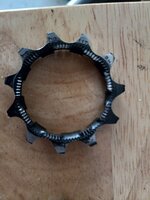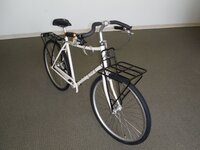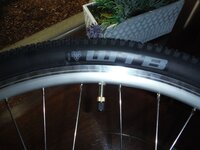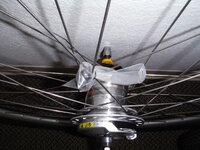I have been riding, mostly on the road, but some when I go camping for years. I just switched in April from a Trek 7100 to a Trek Allant 7. Love the extra power of the bike, however, it has been jerking in high gear. If I go down a notch, it is fine. I took it to the local trek shop for a tune-up, but they either didn't find a problem or more likely didn't try it out as the problem persists. I ride about 75 miles a week so I have close to 1200 miles on it this summer. I'm thinking the chain is stretched. They checked it at the shop, but did not seem concerned. Any suggestions.
You are using an out of date browser. It may not display this or other websites correctly.
You should upgrade or use an alternative browser.
You should upgrade or use an alternative browser.
New man on the block. Could use some advice
- Thread starter Alan Sc
- Start date
-
- Tags
- chain skipping
PedalUma
Well-Known Member
- Region
- USA
- City
- Petaluma, CA
The chain is stretched, but just shy of .05. The real issue it that the final cog is worn on the cassette. Only five teeth are engaged at any given time. On lower gears the load is more distributed. On the high gear all of the strain is concentrated and you ride hard and fast. With some cassettes you can replace the final two or three cogs, for this very reason. When you do, put on a new chain. Or you can just replace the cassette and chain, possibly with ones that are stronger and not pricy.
PedalUma
Well-Known Member
- Region
- USA
- City
- Petaluma, CA
I have been having good performance with these $22 cassettes from Amazon. I work on many eBikes and want people to have value.

Bibike 8/9/10/11 Speed Bike Cassette 11-25T/11-28T/11-32T/11-36T Lightweight Road Bike Cassette Compatible with Shimano Sram(Except XD)
Update for you I replaced my cassette today. The new one works great. I am still having trouble adjusting the gears. I don't quite have the knack for that. Here's a pic of the old cassette. The last two cogs were separate and could be replaced without replacing the entire cassette. I'll need to figure out how to order just one cog. Always something new to learn.
Attachments
alphacarina
Active Member
- Region
- USA
That one is very well worn. If the rest of the cassette looks half as bad, I'd toss all of it and go with new - Your chains will last lots longer
Don
Don
PedalUma
Well-Known Member
- Region
- USA
- City
- Petaluma, CA
Update for you I replaced my cassette today. The new one works great. I am still having trouble adjusting the gears. I don't quite have the knack for that. Here's a pic of the old cassette. The last two cogs were separate and could be replaced without replacing the entire cassette. I'll need to figure out how to order just one cog. Always something new to learn.
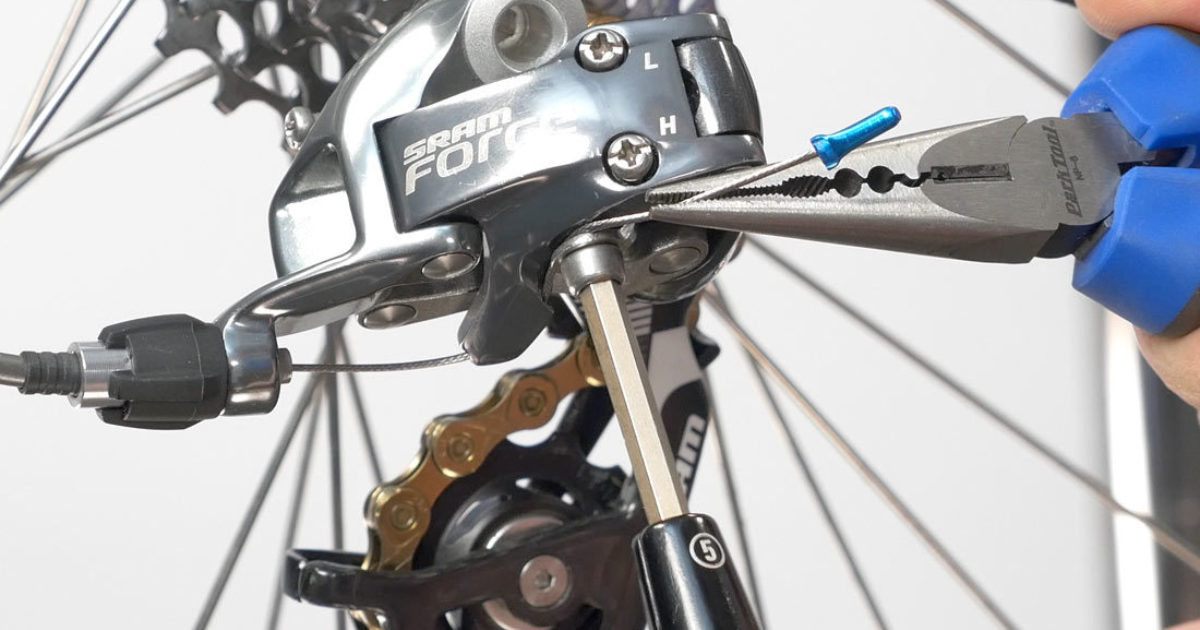
Rear Derailleur Adjustment
The article will discuss adjustment of rear derailleur limit screws and indexing.
Thanks for the video. I've watched these. It seems there is a bit of an art to it that I have not yet mastered. I have the inner and outer stops good, it is the shift from 8 to 9 that is still a bit glitchy.
Rear Derailleur Adjustment
The article will discuss adjustment of rear derailleur limit screws and indexing.www.parktool.com
Stefan Mikes
Gravel e-biker
- Region
- Europe
- City
- Mazovia, PL
Typically, the two smallest cogs are sold as a set, as these two wear the fastest.Update for you I replaced my cassette today. The new one works great. I am still having trouble adjusting the gears. I don't quite have the knack for that. Here's a pic of the old cassette. The last two cogs were separate and could be replaced without replacing the entire cassette. I'll need to figure out how to order just one cog. Always something new to learn.
I hope you have replaced your chain as well? (Replacing chain at 0.5% mark saves your cassette cogs).
PedalUma
Well-Known Member
- Region
- USA
- City
- Petaluma, CA
1) Yes. The chain must be replaced at the same time because now they are differently sized. Cogs and chains expand to fit each other. That is "stretch." But it is a lot more involved than that simple term suggests.
2) Look for your Derailleur Hanger Alignment. There are ways of adjusting this without special tools but if it is out of alignment, just take it to a bike shop and they can fix it in two-minutes with a DAG, an $80 tool for this purpose.
3) Check the B-screw adjustment. As a personal preference I like it in closer than most because I want as many cog teeth engaged in the chain as I can get away with.
Somewhat off topic, I am making a bike right now that will never have these problems. It is getting an extra-wide and extra-strong chain. I just made it an internally braked, with an internally geared eight-speed hub. The bike was covered in rust when a local CEO purchased it for $150 from Craigslist. It is getting a mid-drive, no throttle, torque sensor system with 95Nm. Does the battery look like a water bottle? It will be a gravel/touring bike, and came in a couple of days ago as a three-speed Raleigh ready for the trash bin. That is recycling.
2) Look for your Derailleur Hanger Alignment. There are ways of adjusting this without special tools but if it is out of alignment, just take it to a bike shop and they can fix it in two-minutes with a DAG, an $80 tool for this purpose.
3) Check the B-screw adjustment. As a personal preference I like it in closer than most because I want as many cog teeth engaged in the chain as I can get away with.
Somewhat off topic, I am making a bike right now that will never have these problems. It is getting an extra-wide and extra-strong chain. I just made it an internally braked, with an internally geared eight-speed hub. The bike was covered in rust when a local CEO purchased it for $150 from Craigslist. It is getting a mid-drive, no throttle, torque sensor system with 95Nm. Does the battery look like a water bottle? It will be a gravel/touring bike, and came in a couple of days ago as a three-speed Raleigh ready for the trash bin. That is recycling.
Attachments
Alaskan
Well-Known Member
It is always the smallest cogs that wear out first. They are holding onto the chain with so few teeth they just have so much extra force being applied.
I have two bikes with Shimano XT 11 speed 11-46 tooth cassettes and one with the 12 speed 10-52 tooth XTR. You can get replacement small cogs for both of these cassettes on ebay.
I Inspect them for wear regularly and replace the small cogs as needed this basically doubles the cassette life or more. A stretched chain will increase wear on the cogs and vice versa. Thus I am religious about cleaning and lubing my chains every 100 miles or so. I replace them when they get to .05% stretch so they don't put excessive wear on the cogs.
I ride hard and do an average speed close to 18mph. All my bike have speed motors so my chains don't last more then about 1500 miles and the small cogs need replacing every 2000 to 2500 miles.
Word to the wise on Shimano chains. The lesser chains are heavier but wear better. Shimano's higher cost chains weigh less but also have a shorter life, especially on an ebike.
I have two bikes with Shimano XT 11 speed 11-46 tooth cassettes and one with the 12 speed 10-52 tooth XTR. You can get replacement small cogs for both of these cassettes on ebay.
I Inspect them for wear regularly and replace the small cogs as needed this basically doubles the cassette life or more. A stretched chain will increase wear on the cogs and vice versa. Thus I am religious about cleaning and lubing my chains every 100 miles or so. I replace them when they get to .05% stretch so they don't put excessive wear on the cogs.
I ride hard and do an average speed close to 18mph. All my bike have speed motors so my chains don't last more then about 1500 miles and the small cogs need replacing every 2000 to 2500 miles.
Word to the wise on Shimano chains. The lesser chains are heavier but wear better. Shimano's higher cost chains weigh less but also have a shorter life, especially on an ebike.
Correct shifting will affect cassette and chain life. This involves the system being adjusted correctly, lubed and clean chain and how and when you shift.The rest of the cogs look OK, but I don't know how to get a replacement for just one cog. I can't seem to find an exact match. Either way, I already replaced the entire cassette. Now if I could just get those gears right.
PedalUma
Well-Known Member
- Region
- USA
- City
- Petaluma, CA
Save this link: https://www.kmcchain.com/en/model/e-bikeThe lesser chains are heavier but wear better.
That's correct. The lightweight high-end chains from Campagnolo and Shimano are for non-electric bikes on race day to win that race that day. They are like spark plugs in a race car, expendable. Those chains are all about shaving off fractions of a gram. Give me the heavy duty, wide single speed chain and I will run it to an internal hub of gears when I have it hooked up to a 1Hp motor plus me.
Similar threads
- Replies
- 6
- Views
- 2K
